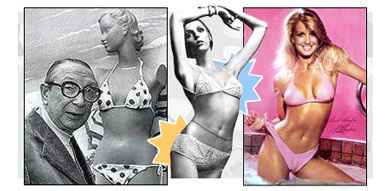Bikini

Fashion Synopsis
The scandalously skimpy bikini was, according to designer Jean Reard, “smaller than the world’s smallest bathing suit.” At that time, the smallest suit was the 'atom,' the original two-piece precursor to the bikini, created by Jacques Helm. Reards' bikini completely smashed the atom: with a scant 30 inches making up the tiny bra top and triangular bottom, the suit barely covered the body of the young girls clamoring to wear it. Thanks to the itsy bitsy teenie weenie bikini, neither bathing suits nor the beaches would ever be the same.
The bikini made its official debut the summer of 1946, just a few days after the U.S. Military conducted nuclear tests and exploded the H-bomb on the Bikini Atoll, a string of islands in the Pacific. French designer Reard, still lacking a name for his new suit, capitalized on the exotic local and newsworthy event. The public, primed by the media, was ready to witness the even more shocking blast of the bombshell suit named the bikini.
The slinky suit was deemed so indecent that French models refused to wear it for the runway. Reard found a willing model in Micheline Bernardini, a nude dancer at the Casino de Paris. Her scantily-clad photos made her an immediate sex symbol, and forever declared the bikini the symbol of sex.
The two-piece bathing suit was nothing new: in fact, due to the wartime rationing of fabric during WWII, conservative two-piece suits were introduced in the late 30’s. But the bikini was something new, and it did what no other bathing suit had done before: it exposed the navel. You wouldn’t think the belly button would be a big deal, but in the conservative 40’s, it was almost too much to bear. So shameless was the suit that according to the advertisements, it wasn’t a true bikini “unless it could pulled through a wedding ring.” And it could travel easy: folded up, it could almost fit inside the ring box.
Europe was the first to embrace the bikini, and the French blonde bombshell Brigitte Bardot immortalized the suit in the movie Girl in the Bikini. America, however, wasn’t ready to reveal, and the movie was censored in the U.S. But the shocking soon became the daring, and girls in America braved the tiny bikini. Censors weren’t quite as adventurous, and they made it their duty to prohibit the suit from the country’s beaches. Guards measured the girls in their bathing suits to make sure that they didn’t reveal too much. You’d get the stamp of approval if, like a respectable girl, you kept your belly button under wraps. If not, the bikini got you booted from the beach. No fun in the sun unless you were covered up.
As America’s morals loosened in the 60’s, the bullet-bra and hipster brief bikini made a big splash. Singer Brian Hyland immortalized the suit with his song “Itsy Bitsy Teenie Weenie Yellow Polka Dot Bikini,” and fresh-faced Frankie Avalon and Annette Funicello starred in a series of beach blanket movies that featured bikini-clad girls dancing on the beach. Now that’s progress.
Bikinis became barewear for all walks of life, and brought innocent sexploitation to the big screen. Raquel Welch enflamed the primal urges in her prehistoric fur bikini in One Million Years B.C., and Jane Fonda’s Barbarella was outta this world as a futuristic bikini babe. The 70’s got even teenier with the string bikini, and the tiny top made a turn on the disco floor when paired with designer jeans or slinky satin shorts. The bikini made its nighttime debut, and there was no stopping it.
The bikini contests of the 80’s and 90’s solidified the bikini’s place in shockwear, and the bikini become even more scandalous than it was in its infancy. If you can believe it, the bikini became even smaller, as Brazilian cut thongs became the bottom of choice for sun worshippers. And if the trend keeps up, don’t be surprised to see a bikini so small it can be pulled through the eye of a needle.
